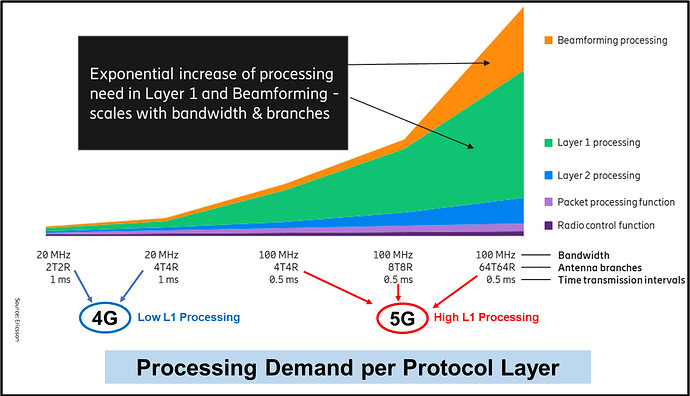-
My friend: Hi Ibrahim, I am really confused

- Me: Why? What is the problem?
-
My friend: I am hearing a lot about using L1 acceleration in 5G, but I don’t understand why acceleration was mentioned in 5G specifically and not in 4G for example? Could you please explain it?
- Me: Sure. As you know, in Rel.15, 3GPP defined the 5G baseband unit to be composed of CU and DU using HLS (Higher Layer Split) by option 2, where DU will handle L1 functions. Also, with Open RAN, when LLS (Lower Layer Split) was introduced using option 7.2x, DU will still handle the higher part of L1 functions such as channel estimation, modulation/demodulation, FEC (Forward Error Correction), so the problem is that these L1 functions are real-time, very complex and consume a lot of computing power specially in 5G compared with 4G as 5G will have higher speed and lower latency which means 5G needs more efficient HW and faster processing of L1 functions, please check the below graph. And to meet these requirements in 5G, some techniques inside these L1 functions were introduced in 5G and were not in 4G. For example, 5G is using LDPC coding instead of Turbo coding, which is used in 4G, and LDPC is more complex and requires more computation power.
-
My friend: Ok, it is clearer now, but why the L1 acceleration was started with 5G Cloud RAN and Open RAN?
- Me: The common thing between Open RAN, Cloud RAN and even vRAN is the disaggregation of HW from SW. So, we are using COTS HW from any vendor and install the SW of any 5G function, like DU, on it. The problem of this approach is that the COTS HW is less efficient compared with the purpose-built HW that is built specifically for RAN. So, it is like using a normal PC that can be used for any purpose to play games compared with a gaming PC that was designed specifically for gaming
 . So, we need to enhance the COTS HW by offloading these complex, real-time, and compute-intensive functions from it to a HW accelerator to enhance the whole performance in 5G Cloud RAN and Open RAN.
. So, we need to enhance the COTS HW by offloading these complex, real-time, and compute-intensive functions from it to a HW accelerator to enhance the whole performance in 5G Cloud RAN and Open RAN.
- Me: The common thing between Open RAN, Cloud RAN and even vRAN is the disaggregation of HW from SW. So, we are using COTS HW from any vendor and install the SW of any 5G function, like DU, on it. The problem of this approach is that the COTS HW is less efficient compared with the purpose-built HW that is built specifically for RAN. So, it is like using a normal PC that can be used for any purpose to play games compared with a gaming PC that was designed specifically for gaming
-
My friend: But why we are using COTS HW if it is not efficient compared with purpose-built HW?
- Me: Simply, it is cheaper, and it will prevent vendor lock-in, so you can use any HW from any vendor. Also, it can be available in shorter time than the purpose-built HW as different vendors can provide it and not a specific vendor who should ship it from its warehouses which can be very far from the network location. So, you need to compromise between these advantages and the performance limitation by using the HW accelerator which can be implemented using FPGA, ASIC or GPU.
-
My friend: Thank you very much, you made it very clear.
- Me: You are most welcome.
LinkedIn: ![]()
